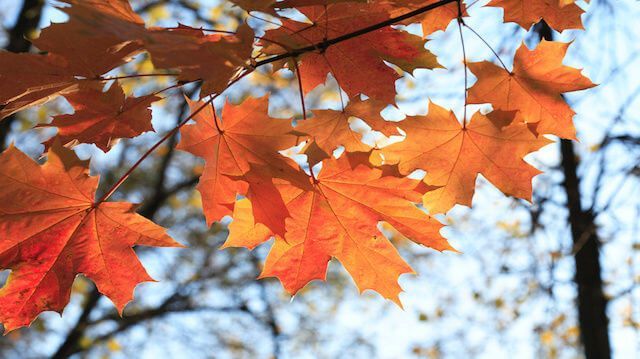
As the days get shorter and the temperatures drop, we tend to naturally adapt our behaviors to match… once we stop denying summer is over, that is! There’s no need to resist getting those jackets and sweaters out of the closet — why not make an effort to admire and enjoy the autumnal beauty?
It’s important to adjust our cooking and eating habits as the season turns, and this requirement is highlighted by Ayurvedic wisdom. Ayurveda is the ancient Indian tradition of whole-body medicine, which is still widely practiced today.
Similar to Chinese medicine, Ayurveda places certain foods into groups according to the seasons. This is largely in keeping with the produce that nature gives us at particular times of the year.
If you’ve ever shopped at the local farmers’ market, you will have noticed that the produce starts to change in the autumn — we see lots of gourds, winter squashes, apples, onions and root vegetables.
Ayurvedic philosophy holds that eating warming foods in the fall and winter is vital in order to keep the body healthy and balanced. It suggests that the metabolism works harder to keep us warm in the winter, and therefore the “digestive fire” must be adequately fueled with heavier foods. Ayurveda says that cold, damp foods like salads and smoothies, which might seem delicious and perfect in the summertime, can sap the body of energy and even leave it vulnerable to illness during the fall and winter.
Let’s delve into some of the warming foods recommended by Ayurveda to support robust immunity, steady energy and a buoyant mood throughout the cold seasons.
Butter and ghee: Fats are recommended for winter consumption because they provide a steady burn of energy to keep us warm. Putting on a few comfortable pounds during the winter is considered healthy, according to Ayurveda.
Raw honey: It is said that eating raw honey in the winter has a heating and drying effect, which can clear mucus brought on by a cold or flu. Remember not to mix raw honey into anything hot as its natural properties will be destroyed.
Ginger: Always keep ginger root on hand throughout the winter to keep the immune system healthy and ward off infections. Grating the root and squeezing the juice into hot water is a great quick remedy if you’re feeling under the weather.
Oatmeal: Since a large percentage of oatmeal is contaminated with gluten, we recommend either seeking out a tested and certified gluten-free variety, or making porridge with an alternative like chia seeds or buckwheat groats.
Cinnamon: Cinnamon is one of the most delicious warming spices and should feature in many recipes to keep you balanced throughout the winter.
Red wine: Ayurveda encourages the occasional glass of red wine to stimulate digestion and circulation. Add warming spices to create a delicious mulled concoction.
Chicken broth: Greater consumption of meats and fats is encouraged (and likely craved) during the winter. Making your own organic chicken broth in the Crock-Pot is the best way to get your hands on this delicious and health-supporting food.
Turmeric: Ayurveda considers turmeric to be the “crown jewel of spices.” It has potent anti-inflammatory effects and helps fight all manner of illness. Try to consume some every day in the form of soup or curry.
 Sweet potatoes: Vegetables rich in vitamin A and C, like sweet potatoes, are the perfect warming and grounding food to enjoy all winter long. They taste great steamed and topped with ghee and cinnamon, or roasted with ginger and chili peppers.
Sweet potatoes: Vegetables rich in vitamin A and C, like sweet potatoes, are the perfect warming and grounding food to enjoy all winter long. They taste great steamed and topped with ghee and cinnamon, or roasted with ginger and chili peppers.
Chai tea: This is the ultimate conglomeration of warming spices. To make your own, boil cloves, nutmeg, cinnamon, cardamom and ginger in water, then add black tea and a milk of your choice. Use rooibos as a caffeine-free alternative to warm you up in the evening.
Chili peppers: Hot peppers are the epitome of a warming food — you can feel the body responding as soon as you eat them. Freshly chopped peppers or the dried powder will add a little spice to any cooked dish.
Carrots: Here’s another root vegetable that is a winter staple. Ayurvedic wisdom recommends pairing carrots with a warming spice like ginger and cooking them in stock to make a nourishing soup. Carrots are rich in vitamins that help bolster the immune system in the winter.
Asparagus: While raw or cold vegetables are off the cards for winter consumption, asparagus makes the cut because it is best eaten steamed or roasted.
Mustard seed: The sour, salty taste of mustard fits with the winter flavors recommended by Ayurveda. Try adding mustard or mustard seeds to roast potatoes or carrots.
Cardamom: Cardamom usually appears in sweet baked goods in Scandinavian cuisine, whereas Eastern cuisine uses it in more savory dishes. Cardamom belongs in the group of “warming spices” according to Ayurveda, and it is delicious in curry dishes or even in homemade chai tea.
Cumin: This warming spice is ultra-earthy and goes great in wintry savory dishes. In Ayurvedic medicine, it is used as a digestive tonic. It stokes the digestive fire by stimulating the production of pancreatic enzymes. Cumin is said to dispel gas, improve digestion and reduce inflammation.
Stewed fruit: Ayurveda recommends sweet, sour, heavy fruits in the colder months. This could include cherries, peaches, plums and bananas. Cooking the fruit in some butter and milk (or milk alternative) and adding some warming spice such as cardamom or cinnamon is the perfect way to adapt fruit for cold weather.
Beets: Root vegetables are definitely a mainstay of winter cuisine. They store well and make for a flexible go-to that is delicious in many winter dishes. Try roasting spiced beets in butter and then tossing them with goat’s cheese and nuts.
Risotto: Once you’re tired of all those roasted root vegetables and hearty stews, risotto makes for a nice change. Gluten-free whole grains are recommended as a warming food, so why not cook up some of that delicious rice in a nourishing creamy dish with herbs and mushrooms.
Tahini: Sesame seeds are widely used in Ayurveda. In fact, one of the top recommended oils for massage (and especially self-massage for lymphatic movement during the winter) is sesame oil. Tahini is a purée of sesame seeds, which makes for a great source of fat to keep warm during the winter.
Some other Ayurvedic practices for keeping warm and healthy in the colder months
Ayurveda recommends frequent saunas, steams and massages to stimulate circulation and warmth in the winter. Sex is also encouraged, if you needed an excuse! Practice yoga, such as sun salutations and deep breathing exercises, often to keep the inner fire burning and stay grounded.
Avoid eating damp and cooling foods, or those that encourage congestion, including most dairy, sweets and yeast. These foods are said to encourage illness in the winter. If you do get sick, try a neti pot!
Why not head out to the farmers’ market and experience some of these Ayurvedic warming foods firsthand? There is nothing more satisfying than nourishing your body in harmony with the rhythms of the earth. Read more about the holistic way to prepare for autumn.
—The Alternative Daily
Sources:
http://holisticonline.com/ayurveda/ayv-food-classification.htm
http://www.ayurvedicyogi.com/warding-off-the-winter-chill-with-ayurveda
http://www.yogajournal.com/article/eat-for-your-dosha/qa-cold-warming-foods-according-ayurveda

